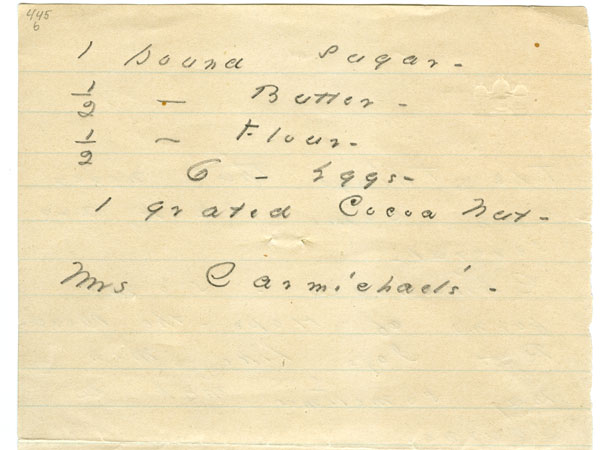 Recipe or poem? Emily Dickinson’s recipe for “Cocoa Nut” cake. 445B: courtesy of Amherst College Archives and Special Collections by permission of the Trustees of Amherst College.
Recipe or poem? Emily Dickinson’s recipe for “Cocoa Nut” cake. 445B: courtesy of Amherst College Archives and Special Collections by permission of the Trustees of Amherst College.
We’ve got a guest post this week from Aife Murray, author of Maid as Muse: how servants changed Emily Dickinson’s life and language— and I want to let you jump right into it. Read on for a story about Dickinson the poet/cook who would give you the recipe to make a prairie just as soon as she would her recipe for cocoanut cake.
Aife recently spoke about Dickinson at the Lower East Side Tenement Museum. The video of this event is here.
“Waste not, want not” was a maxim in Emily Dickinson’s kitchen. Her family’s well-thumbed housekeeping manual, The American Frugal Housewife by Lydia Maria Child, from 1844, begins this way: “The true economy of housekeeping is simply the art of gathering up all the fragments so that nothing be lost. I mean fragments of time as well as materials.”
Emily Dickinson grabbed every conceivable scrap of paper for her stationary. She wrote poems on the backs of party invitations, bills, recipes, shopping lists, food wrappers(think the chocolate bar wrapper made famous by Joseph Cornell) — the kinds of paper that seem to
“grow” on any kitchen counter. She’d use these scraps to capture a poetic idea that had skidded into the imagination. When my hands are busy grating nutmeg or scrubbing the stove my mind roams broadly and I receive what feel like “gifts” of ideas (Buddhists would call that “naturally occurring wisdom”). In Emily’s case, what rose up might be a great poem. So she gathered up even those fragments of ideas for poems and jotted them on the backs of those fragments of paper collecting by her pantry board.
Emily Dickinson (source)
Another frugal idea, adopted by prize-winning baker Emily Dickinson, came from the sewing room. In order to keep her kitchen-writing life in place she pinned recipes into her cookbook. I’m a tactile learner too. Among the cookbooks on my bookshelf I tuck recipes I’ve torn from magazines or jotted on the back of an envelope when talking food with a friend. Of course those papers are at risk every time I grab a cookbook (but they remind me, as I pick them up, about a dish to try). Perhaps Emily Dickinson had a better idea. She used a simple straight pin to hold these various slips of paper into her family cookbook. She not only pinned recipes but she pinned her poems together.
Emily’s original of the coconut cake recipe, below, has two small pin holes in it. On the reverse of the recipe she began writing the poem “The things that never can come back” but then the poem got longer and she grabbed another sheet of paper to finish it. And so, as she might pin a recipe together in her “receipt book,” she took a straight pin to keep the pieces of the poem together. Look at the dashes in this recipe – she’s famous for using dashes (which came first? The recipe dash or the poem dash?):
1 Pound Sugar –
½ Pound Butter –
½ Pound Flour –
6 – Eggs –
1 grated Cocoa Nut –
It turns out inspired writing is a lot like inspired cooking. And Emily Dickinson easily adapted kitchen practices to her writing. Recipes — a simple list with proportions — are as concise as poetry. I think recipes were a suggestive form for Emily Dickinson, just as much as sonnets or haiku. Doesn’t her coconut cake recipe look an awful lot like this “recipe” for mixing up a prairie?
To make a prairie it takes a clover and one bee,
One clover, and a bee,
And revery.
The revery alone will do,
If bees are few.
©Aífe Murray, San Francisco, September 2-10, 2012
***
Read More!
Maid as Muse: How Servants Changed Emily Dickinson’s Life and Language (Revisiting New England)



Pingback: Maid as Muse - How Servants Changed Emily Dickinson's Life and Language
Do you know of any books or websites that have photos of Dickinson’s handwritten text, and the books she made? There are some examples in Aife Murray’s book, I would love to see more.
Emily Dickinson fans should visit http://www.cridington.com/ for a real treat!
Has anyone tried this recipe? I’m a little concerned about the lack of a leavening agent, but it does have an awful lot of eggs…
There’s a slightly different version of it on this blog: http://thehistorykitchen.com/2011/12/09/emily-dickinsons-coconut-cake/
Excellent Public School takes pride in country’s
age old morals and values and tries to pass them on to the young generation through a developed education system.
The Individuals With Disabilities Education Act was adopted by Congress in 1975 to mandate how States should provide education to special needs children
from birth to age 21. Executive education is one such factor
that can ensure that a professional is able to gain all the
latest skills and knowledge that is required to cope up with the
dynamic changes in the global market which furthermore ensure the growth and development
of the organization.
Pingback: Maid as Muse » Page not found - How Servants Changed Emily Dickinson's Life and Language
Something else is that while searching for a good on the net electronics retail outlet, look for web shops that are constantly updated, retaining up-to-date with the newest products, the top deals, plus helpful information on services. This will make certain you are getting through a shop that stays on top of the competition and offers you things to make knowledgeable, well-informed electronics buying. Thanks for the critical tips I have learned from the blog.